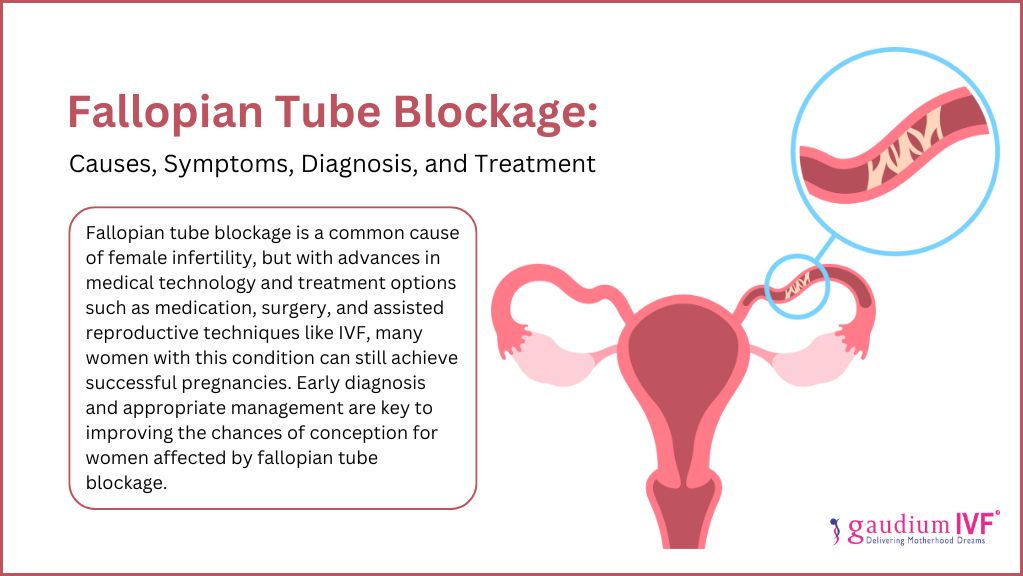
Fallopian tube blockage, medically known as tubal occlusion, is a condition where one or both of the fallopian tubes are obstructed, hindering the passage of eggs from the ovaries to the uterus. This obstruction can prevent conception and lead to infertility in women. In this blog with Gaudium IVF, the best IVF Center in Mumbai we will understand the causes, symptoms, diagnosis, and treatment options for Blocked Fallopian Tubes, which is crucial for those affected by this condition.
Fallopian Tube Blockage Causes:
Several factors can contribute to the blockage of fallopian tubes. Some common causes include:
1. Pelvic Inflammatory Disease (PID)
PID is often caused by sexually transmitted infections such as chlamydia and gonorrhea. If left untreated, PID can lead to scarring and blockage of the fallopian tubes.
2. Endometriosis
This condition occurs when the tissue lining the uterus grows outside the uterus. Endometrial tissue can implant itself on the fallopian tubes, leading to blockages and fertility issues.
3. Previous Surgery
Surgeries such as pelvic surgery or surgeries to treat ectopic pregnancies can result in scar tissue formation, which may block the fallopian tubes.
4. Pelvic Adhesions
Adhesions are bands of scar tissue that can form between pelvic organs, including the fallopian tubes, due to previous surgeries, infections, or inflammation.
5. Congenital Abnormalities
Some women may be born with structural abnormalities in their fallopian tubes that can predispose them to blockages.
Fallopian Tube Blockage Symptoms:
Fallopian tube blockage often does not present any symptoms until a woman experiences difficulty getting pregnant. However, in some cases symptoms may include:
- Chronic pelvic pain
- Pain during intercourse
- Foul smelling vaginal discharge
- Fever over 101 (in acute cases)
Blocked Fallopian Tubes Diagnosis:
The diagnosis of fallopian tube blockage typically involves a combination of medical history, physical examination, and diagnostic tests. These tests may include:
1. Hysterosalpingography (HSG)
This is a specialized X-ray procedure where a contrast dye is injected into the uterus and fallopian tubes, allowing the physician to visualize any blockages or abnormalities on X-ray images.
2. Sonohysterography
This ultrasound procedure involves the injection of saline solution into the uterus to provide a detailed ultrasound image of the uterine cavity and fallopian tubes.
3. Laparoscopy
In some cases, a minimally invasive surgical procedure called laparoscopy may be performed to directly visualize the pelvic organs, including the fallopian tubes, and to assess for any blockages or abnormalities.
Fallopian Tube Blockage Treatment:
The treatment of fallopian tube blockage depends on the underlying cause and the severity of the obstruction. Some treatment options include:
1. Medication
Antibiotics may be prescribed to treat infections such as PID, which can help reduce inflammation and clear any blockages caused by infection.
2. Surgery
In cases where blockages are caused by scar tissue or adhesions, surgical procedures such as laparoscopic surgery may be performed to remove the blockages and restore the normal function of the fallopian tubes.
3. In vitro fertilization (IVF)
For women with severe Blocked Fallopian Tubes or irreversible damage to the tubes, IVF from the best IVF Clinic in Mumbai may be recommended as a treatment option. IVF involves the retrieval of eggs from the ovaries, fertilizing them with sperm in a laboratory, and transferring the embryos into the uterus for implantation.
Conclusion
Fallopian tube blockage is a common cause of female infertility, but with advances in medical technology and treatment options such as medication, surgery, and assisted reproductive techniques like IVF, many women with this condition can still achieve successful pregnancies. Early diagnosis and appropriate management are key to improving the chances of conception for women affected by fallopian tube blockage.



